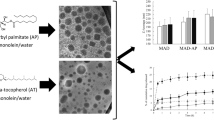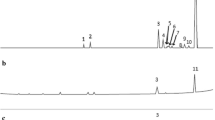Abstract
This work was carried out to exploit the feasibility of microemulsion combining apigenin/hydroxypropyl-β-cyclodextrin (API/HP-β-CD) complex as the carrier for improving the solubility of API, a bioactive flavonoid with various pharmacological activities. The API/HP-β-CD complex in solid state was prepared by solvent-freeze-drying method and characterized by FT-IR, PXRD and 1H NMR. To further increase the solubility of API, the complex of HP-β-CD with food-grade cosurfactant-free microemulsion was constructed. The aqueous solubility of API significantly increases in the HP-β-CD/Microemulsion complex, via solubilizing dominantly into the “palisade” layer, minor outer phase and inner core. The HP-β-CD modified microemulsion improves the cumulative percentage of API released. Moreover, API loaded in microemulsions with HP-β-CD had a higher antioxidant activity than that without HP-β-CD.








Similar content being viewed by others
References
Peterson, J., Dwyer, J.: Flavonoids: dietary occurrence and biochemical activity. Nutr. Res. 18(12), 1995–2018 (1998)
Wu, Q., Yu, C., Yan, Y., Chen, J., Zhang, C., Wen, X.: Antiviral flavonoids from Mosla scabra. Fitoterapia 81(5), 429–433 (2010). doi:10.1016/j.fitote.2009.12.005
Al Shaal, L., Shegokar, R., Muller, R.H.: Production and characterization of antioxidant apigenin nanocrystals as a novel UV skin protective formulation. Int. J. Pharm. 420(1), 133–140 (2011). doi:10.1016/j.ijpharm.2011.08.018
Funakoshi-Tago, M., Nakamura, K., Tago, K., Mashino, T., Kasahara, T.: Anti-inflammatory activity of structurally related flavonoids, apigenin luteolin and fisetin. Int. Immunopharmacol. 11(9), 1150–1159 (2011). doi:10.1016/j.intimp.2011.03.012
Shukla, S., Gupta, S.: Apigenin: a promising molecule for cancer prevention. Pharm. Res. 27(6), 962–978 (2010). doi:10.1007/s11095-010-0089-7
Way, T.D., Kao, M.C., Lin, J.K.: Apigenin induces apoptosis through proteasomal degradation of HER2/neu in HER2/neu-overexpressing breast cancer cells via the phosphatidylinositol 3-kinase/Akt-dependent pathway. J. Biol. Chem. 279(6), 4479–4489 (2004). doi:10.1074/jbc.M305529200
Lee, W.J., Chen, W.K., Wang, C.J., Lin, W.L., Tseng, T.H.: Apigenin inhibits HGF-promoted invasive growth and metastasis involving blocking PI3 K/Akt pathway and β4 integrin function in MDA-MB-231 breast cancer cells. Toxicol. Appl. Pharmacol. 226(2), 178–191 (2008). doi:10.1016/j.taap.2007.09.013
Salabat, M.R., Golkar, L., Ding, X.Z., Ujiki, M.B., Pelling, J.C., Bell, R.H., Adrian, T.E., Talamonti, M.S., Bentrem, D.J.: Apigenin causes growth arrest in pancreatic cancer cells through down-regulation of the replication inhibitor protein, geminin via both transcription and ubiquitin-mediated degradation. J. Am. Coll. Surg. 203(3), 85 (2006)
Vargo, M.A., Voss, O.H., Poustka, F., Cardounel, A.J., Grotewold, E., Doseff, A.I.: Apigenin-induced-apoptosis is mediated by the activation of PKCδ and caspases in leukemia cells. Biochem. Pharmacol. 72(6), 681–692 (2006). doi:10.1016/j.bcp.2006.06.010
Chen, D., Daniel, K.G., Chen, M.S., Kuhn, D.J., Landis-Piwowar, K.R., Dou, Q.P.: Dietary flavonoids as proteasome inhibitors and apoptosis inducers in human leukemia cells. Biochem. Pharmacol. 69(10), 1421–1432 (2005). doi:10.1016/j.bcp.2005.02.022
Zhang, J., Liu, D., Huang, Y., Gao, Y., Qian, S.: Biopharmaceutics classification and intestinal absorption study of apigenin. Int. J. Pharm. 436(1–2), 311–317 (2012). doi:10.1016/j.ijpharm.2012.07.002
Hu, M., Chen, J., Lin, H.: Metabolism of flavonoids via enteric recycling: mechanistic studies of disposition of apigenin in the Caco-2 cell culture model. J. Pharmacol. Exp. Ther. 307(1), 314–321 (2003). doi:10.1124/jpet.103.053496
Szente, L., Szejtli, J.: Highly soluble cyclodextrin derivatives: chemistry, properties, and trends in development. Adv. Drug Deliv. Rev. 36(1), 17–28 (1999). doi:10.1016/S0169-409X(98)00092-1
Li, J., Yu, K., Bai, J., Zhang, H., Chao, J.: Study and characterization of the antioxidant activity of the inclusion complex of apigenin with beta-cyclodextrin and HP-beta-cyclodextrin in solution. J. Investig. Biochem. 3(3), 107 (2014). doi:10.5455/jib.20140905032504
Papay, Z.E., Sebestyen, Z., Ludanyi, K., Kallai, N., Balogh, E., Kosa, A., Somavarapu, S., Boddi, B., Antal, I.: Comparative evaluation of the effect of cyclodextrins and pH on aqueous solubility of apigenin. J. Pharm. Biomed. Anal. 117, 210–216 (2016). doi:10.1016/j.jpba.2015.08.019
Hyunmyung, K., Hyun-Won, K., Seunho, J.: Aqueous solubility enhancement of some flavones by complexaton with cyclodextrins. Bull. Korean Chem. Soc. 29(3), 5 (2008)
Gould, S., Scott, R.C.: 2-Hydroxypropyl-β-cyclodextrin (HP-β-CD): a toxicology review. Food Chem. Toxicol. 43(10), 1451–1459 (2005). doi:10.1016/j.fct.2005.03.007
Thomas, S., Vieira, C.S., Hass, M.A., Lopes, L.B.: Stability, cutaneous delivery, and antioxidant potential of a lipoic acid and α-tocopherol codrug incorporated in microemulsions. J. Pharm. Sci. 103(8), 2530–2538 (2014). doi:10.1002/jps.24053
Ren, Q., Deng, C., Meng, L., Chen, Y., Chen, L., Sha, X., Fang, X.: In vitro, ex vivo, and in vivo evaluation of the effect of saturated fatty acid chain length on the transdermal behavior of ibuprofen-loaded microemulsions. J. Pharm. Sci. 103(6), 1680–1691 (2014). doi:10.1002/jps.23958
Ge, S., Lin, Y., Lu, H., Li, Q., He, J., Chen, B., Wu, C., Xu, Y.: Percutaneous delivery of econazole using microemulsion as vehicle: formulation, evaluation and vesicle-skin interaction. Int. J. Pharm. 465(1–2), 120–131 (2014). doi:10.1016/j.ijpharm.2014.02.012
Lin, C.C., Lin, H.Y., Chi, M.H., Shen, C.M., Chen, H.W., Yang, W.J., Lee, M.H.: Preparation of curcumin microemulsions with food-grade soybean oil/lecithin and their cytotoxicity on the HepG2 cell line. Food Chem. 154, 282–290 (2014). doi:10.1016/j.foodchem.2014.01.012
Wu, H., Long, X., Yuan, F., Chen, L., Pan, S., Liu, Y., Stowell, Y., Li, X.: Combined use of phospholipid complexes and self-emulsifying microemulsions for improving the oral absorption of a BCS class IV compound, baicalin. Acta Pharm. Sin. B 4(3), 217–226 (2014). doi:10.1016/j.apsb.2014.03.002
Dalmora, M.E.A., Oliveira, A.G.: Inclusion complex of piroxicam with β-cyclodextrin and incorporation in hexadecyltrimethylammonium bromide based microemulsion. Int. J. Pharm. 184(2), 157–164 (1999)
Dalmora, M.E., Dalmora, S.L., Oliveira, A.G.: Inclusion complex of piroxicam with β-cyclodextrin and incorporation in cationic microemulsion. In vitro drug release and in vivo topical anti-inflammatory effect. Int. J. Pharm. 222(1), 45–55 (2001)
Ventura, C.A., Giannone, I., Paolino, D., Pistara, V., Corsaro, A., Puglisi, G.: Preparation of celecoxib-dimethyl-β-cyclodextrin inclusion complex: characterization and in vitro permeation study. Eur. J. Med. Chem. 40(7), 624–631 (2005). doi:10.1016/j.ejmech.2005.03.001
Wang, X., Luo, Z., Xiao, Z.: Preparation, characterization, and thermal stability of β-cyclodextrin/soybean lecithin inclusion complex. Carbohydr. Polym. 101, 1027–1032 (2014). doi:10.1016/j.carbpol.2013.10.042
Higuchi, T., Connors, K.A.: Phase-solubility techniques. In: Reilly, C.N. (ed.) Advances in Analytical Chemistry and Instrumentation, pp. 117–212. Wiley, New York (1965)
Wang, Z., Guo, F., Lu, J., Wei, L., Liu, X.: Preparation and properties of Brij97-based curcumin-encapsulated O/W microemulsions. Adv. Mater. Res. 924, 10–17 (2014)
Fan, J., Liu, F., Wang, Z.: Shear rheology and in vitro release kinetic study of apigenin from lyotropic liquid crystal. Int. J. Pharm. 497(1–2), 248–254 (2016). doi:10.1016/j.ijpharm.2015.12.008
Qiu, N., Cheng, X., Wang, G., Wang, W., Wen, J., Zhang, Y., Song, H., Ma, L., Wei, Y., Peng, A., Chen, L.: Inclusion complex of barbigerone with hydroxypropyl-β-cyclodextrin: preparation and in vitro evaluation. Carbohydr. Polym. 101, 623–630 (2014). doi:10.1016/j.carbpol.2013.09.035
Ma, S.X., Chen, W., Yang, X.D., Zhang, N., Wang, S.J., Liu, L., Yang, L.J.: Alpinetin/hydroxypropyl-β-cyclodextrin host-guest system: preparation, characterization, inclusion mode, solubilization and stability. J. Pharm. Biomed. Anal. 67–68, 193–200 (2012). doi:10.1016/j.jpba.2012.04.038
Liu, M., Cao, W., Sun, Y., He, Z.: Preparation, characterization and in vivo evaluation of formulation of repaglinide with hydroxypropyl-β-cyclodextrin. Int. J. Pharm. 477(1–2), 159–166 (2014). doi:10.1016/j.ijpharm.2014.10.038
Komiyama, M., Bender, M.: Importance of apolar binding in complex formation of cyclodextrins with adamantanecarboxylate. J. Am. Chem. Soc. 100, 2259–2260 (1978)
Pawlikowska-Pawlega, B., Misiak, L.E., Zarzyka, B., Paduch, R., Gawron, A., Gruszecki, W.I.: FTIR, 1H NMR and EPR spectroscopy studies on the interaction of flavone apigenin with dipalmitoylphosphatidylcholine liposomes. Biochim. Biophys. Acta 1828(2), 518–527 (2013). doi:10.1016/j.bbamem.2012.10.013
You, X., Xing, Q., Tuo, J., Song, W., Zeng, Y., Hu, H.: Optimizing surfactant content to improve oral bioavailability of ibuprofen in microemulsions: just enough or more than enough? Int. J. Pharm. 471(1–2), 276–284 (2014). doi:10.1016/j.ijpharm.2014.05.031
Zhao, L., Zhang, L., Meng, L., Wang, J., Zhai, G.: Design and evaluation of a self-microemulsifying drug delivery system for apigenin. Drug Dev. Ind. Pharm. 39(5), 662–669 (2013). doi:10.3109/03639045.2012.687378
Aloisio, C., de Oliveira, G.A., Longhi, M.: Cyclodextrin and meglumine-based microemulsions as a poorly water-soluble drug delivery system. J. Pharm. Sci. (2016). doi:10.1016/j.xphs.2015.11.045
Acknowledgments
Support of this work by the National Natural Science Foundation of China (31271933, 31071603) is gratefully acknowledged. The authors also thank Dr. F. Liu for help in UV–Vis spectroscopy analysis.
Author information
Authors and Affiliations
Corresponding author
Electronic supplementary material
Below is the link to the electronic supplementary material.
Rights and permissions
About this article
Cite this article
Zhao, X., Wang, Z. & Li, X. Preparation, in-vitro release and antioxidant potential of formulation of apigenin with hydroxypropyl-β-cyclodextrin modified microemulsion. J Incl Phenom Macrocycl Chem 86, 93–102 (2016). https://doi.org/10.1007/s10847-016-0644-x
Received:
Accepted:
Published:
Issue Date:
DOI: https://doi.org/10.1007/s10847-016-0644-x




